An Examination of Affordable Healthcare in the US: Perspectives
VerifiedAdded on 2023/06/10
|5
|1090
|356
Essay
AI Summary
This essay provides an analysis of affordable healthcare in the United States, examining the Affordable Care Act (ACA) through various sociological lenses. It begins by outlining the functionalist perspective, highlighting how healthcare components contribute to societal stability and interdependence. The essay then delves into the conflict perspective, emphasizing the power dynamics and social inequalities within the healthcare system. It further explores the interactionist perspective, focusing on the symbols, meanings, and interactions related to healthcare. The author expresses personal beliefs about the ACA, suggesting that it may not be equitable for all individuals due to varying socioeconomic statuses and potential racial biases in Medicare provision. The essay concludes by proposing a method for gathering individual beliefs about the ACA through questionnaires and interactions with a diverse population. The essay is supported by references to relevant literature on the topic.
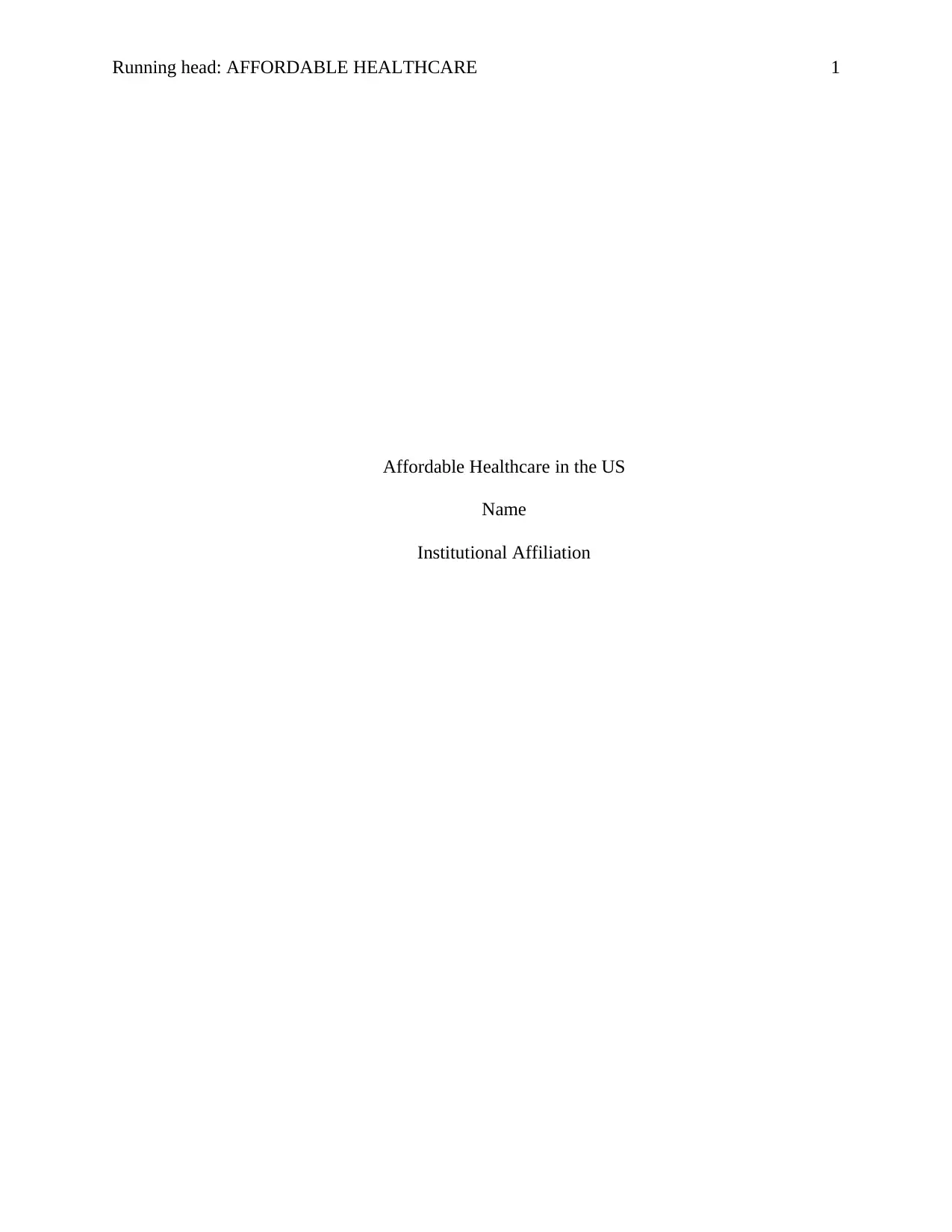
Running head: AFFORDABLE HEALTHCARE 1
Affordable Healthcare in the US
Name
Institutional Affiliation
Affordable Healthcare in the US
Name
Institutional Affiliation
Paraphrase This Document
Need a fresh take? Get an instant paraphrase of this document with our AI Paraphraser
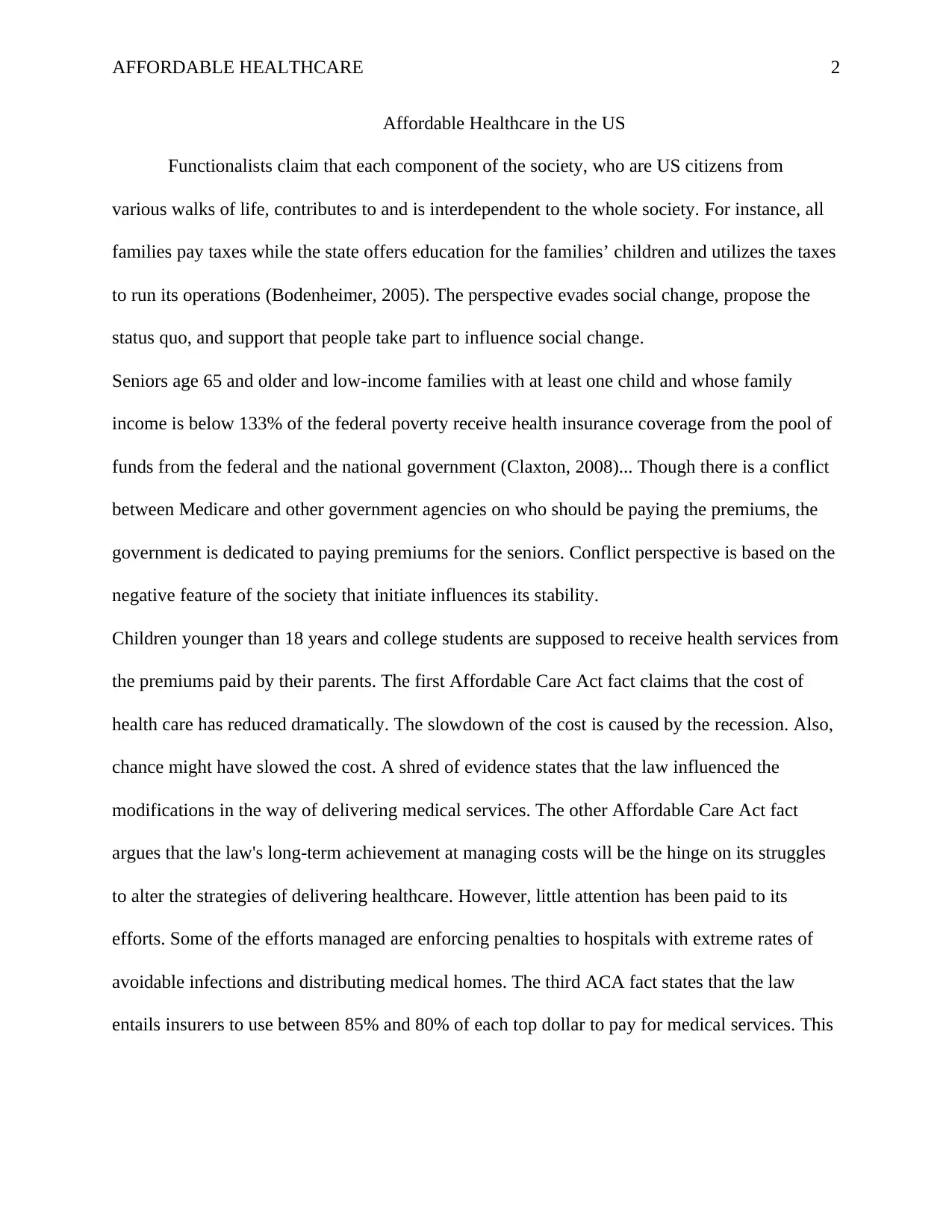
AFFORDABLE HEALTHCARE 2
Affordable Healthcare in the US
Functionalists claim that each component of the society, who are US citizens from
various walks of life, contributes to and is interdependent to the whole society. For instance, all
families pay taxes while the state offers education for the families’ children and utilizes the taxes
to run its operations (Bodenheimer, 2005). The perspective evades social change, propose the
status quo, and support that people take part to influence social change.
Seniors age 65 and older and low-income families with at least one child and whose family
income is below 133% of the federal poverty receive health insurance coverage from the pool of
funds from the federal and the national government (Claxton, 2008)... Though there is a conflict
between Medicare and other government agencies on who should be paying the premiums, the
government is dedicated to paying premiums for the seniors. Conflict perspective is based on the
negative feature of the society that initiate influences its stability.
Children younger than 18 years and college students are supposed to receive health services from
the premiums paid by their parents. The first Affordable Care Act fact claims that the cost of
health care has reduced dramatically. The slowdown of the cost is caused by the recession. Also,
chance might have slowed the cost. A shred of evidence states that the law influenced the
modifications in the way of delivering medical services. The other Affordable Care Act fact
argues that the law's long-term achievement at managing costs will be the hinge on its struggles
to alter the strategies of delivering healthcare. However, little attention has been paid to its
efforts. Some of the efforts managed are enforcing penalties to hospitals with extreme rates of
avoidable infections and distributing medical homes. The third ACA fact states that the law
entails insurers to use between 85% and 80% of each top dollar to pay for medical services. This
Affordable Healthcare in the US
Functionalists claim that each component of the society, who are US citizens from
various walks of life, contributes to and is interdependent to the whole society. For instance, all
families pay taxes while the state offers education for the families’ children and utilizes the taxes
to run its operations (Bodenheimer, 2005). The perspective evades social change, propose the
status quo, and support that people take part to influence social change.
Seniors age 65 and older and low-income families with at least one child and whose family
income is below 133% of the federal poverty receive health insurance coverage from the pool of
funds from the federal and the national government (Claxton, 2008)... Though there is a conflict
between Medicare and other government agencies on who should be paying the premiums, the
government is dedicated to paying premiums for the seniors. Conflict perspective is based on the
negative feature of the society that initiate influences its stability.
Children younger than 18 years and college students are supposed to receive health services from
the premiums paid by their parents. The first Affordable Care Act fact claims that the cost of
health care has reduced dramatically. The slowdown of the cost is caused by the recession. Also,
chance might have slowed the cost. A shred of evidence states that the law influenced the
modifications in the way of delivering medical services. The other Affordable Care Act fact
argues that the law's long-term achievement at managing costs will be the hinge on its struggles
to alter the strategies of delivering healthcare. However, little attention has been paid to its
efforts. Some of the efforts managed are enforcing penalties to hospitals with extreme rates of
avoidable infections and distributing medical homes. The third ACA fact states that the law
entails insurers to use between 85% and 80% of each top dollar to pay for medical services. This
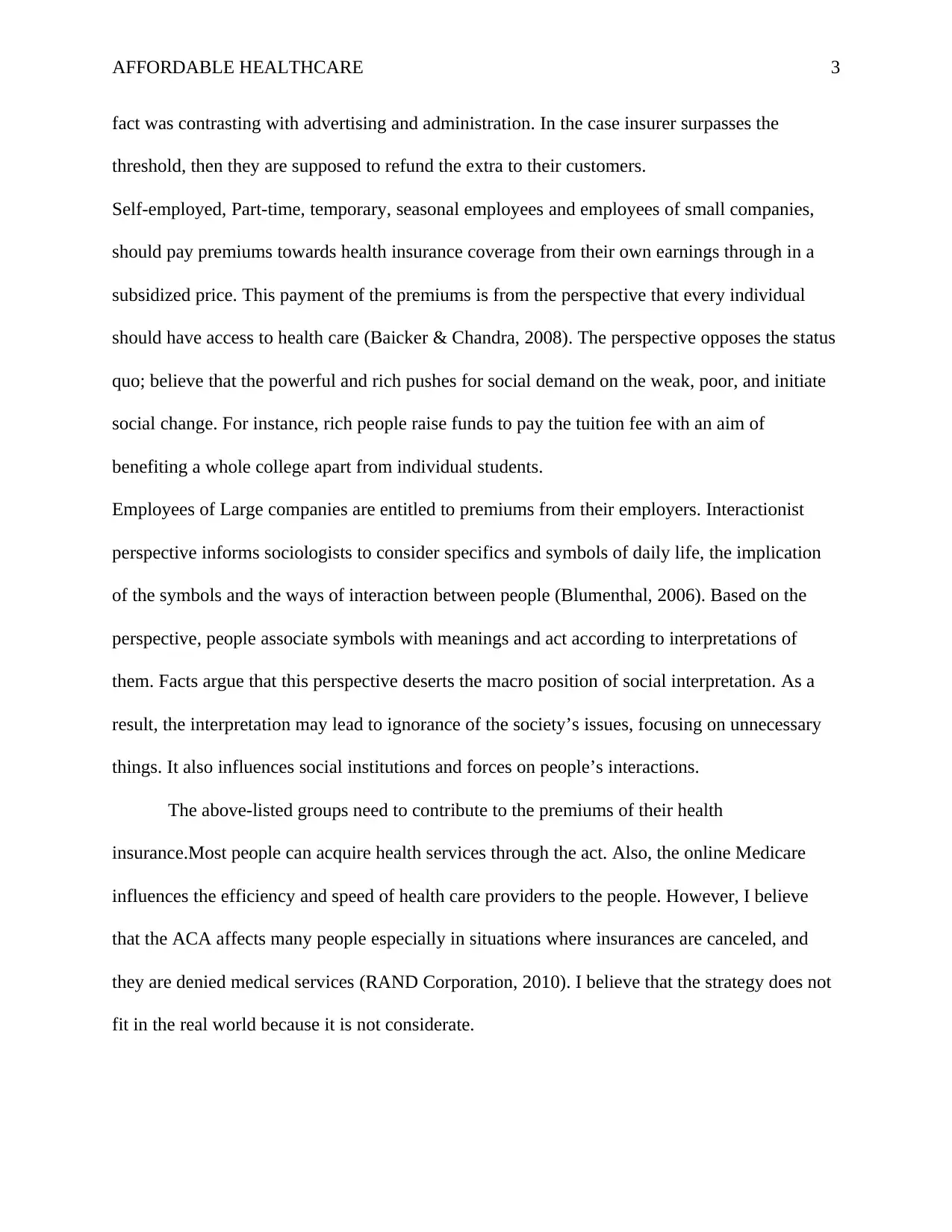
AFFORDABLE HEALTHCARE 3
fact was contrasting with advertising and administration. In the case insurer surpasses the
threshold, then they are supposed to refund the extra to their customers.
Self-employed, Part-time, temporary, seasonal employees and employees of small companies,
should pay premiums towards health insurance coverage from their own earnings through in a
subsidized price. This payment of the premiums is from the perspective that every individual
should have access to health care (Baicker & Chandra, 2008). The perspective opposes the status
quo; believe that the powerful and rich pushes for social demand on the weak, poor, and initiate
social change. For instance, rich people raise funds to pay the tuition fee with an aim of
benefiting a whole college apart from individual students.
Employees of Large companies are entitled to premiums from their employers. Interactionist
perspective informs sociologists to consider specifics and symbols of daily life, the implication
of the symbols and the ways of interaction between people (Blumenthal, 2006). Based on the
perspective, people associate symbols with meanings and act according to interpretations of
them. Facts argue that this perspective deserts the macro position of social interpretation. As a
result, the interpretation may lead to ignorance of the society’s issues, focusing on unnecessary
things. It also influences social institutions and forces on people’s interactions.
The above-listed groups need to contribute to the premiums of their health
insurance.Most people can acquire health services through the act. Also, the online Medicare
influences the efficiency and speed of health care providers to the people. However, I believe
that the ACA affects many people especially in situations where insurances are canceled, and
they are denied medical services (RAND Corporation, 2010). I believe that the strategy does not
fit in the real world because it is not considerate.
fact was contrasting with advertising and administration. In the case insurer surpasses the
threshold, then they are supposed to refund the extra to their customers.
Self-employed, Part-time, temporary, seasonal employees and employees of small companies,
should pay premiums towards health insurance coverage from their own earnings through in a
subsidized price. This payment of the premiums is from the perspective that every individual
should have access to health care (Baicker & Chandra, 2008). The perspective opposes the status
quo; believe that the powerful and rich pushes for social demand on the weak, poor, and initiate
social change. For instance, rich people raise funds to pay the tuition fee with an aim of
benefiting a whole college apart from individual students.
Employees of Large companies are entitled to premiums from their employers. Interactionist
perspective informs sociologists to consider specifics and symbols of daily life, the implication
of the symbols and the ways of interaction between people (Blumenthal, 2006). Based on the
perspective, people associate symbols with meanings and act according to interpretations of
them. Facts argue that this perspective deserts the macro position of social interpretation. As a
result, the interpretation may lead to ignorance of the society’s issues, focusing on unnecessary
things. It also influences social institutions and forces on people’s interactions.
The above-listed groups need to contribute to the premiums of their health
insurance.Most people can acquire health services through the act. Also, the online Medicare
influences the efficiency and speed of health care providers to the people. However, I believe
that the ACA affects many people especially in situations where insurances are canceled, and
they are denied medical services (RAND Corporation, 2010). I believe that the strategy does not
fit in the real world because it is not considerate.
⊘ This is a preview!⊘
Do you want full access?
Subscribe today to unlock all pages.

Trusted by 1+ million students worldwide
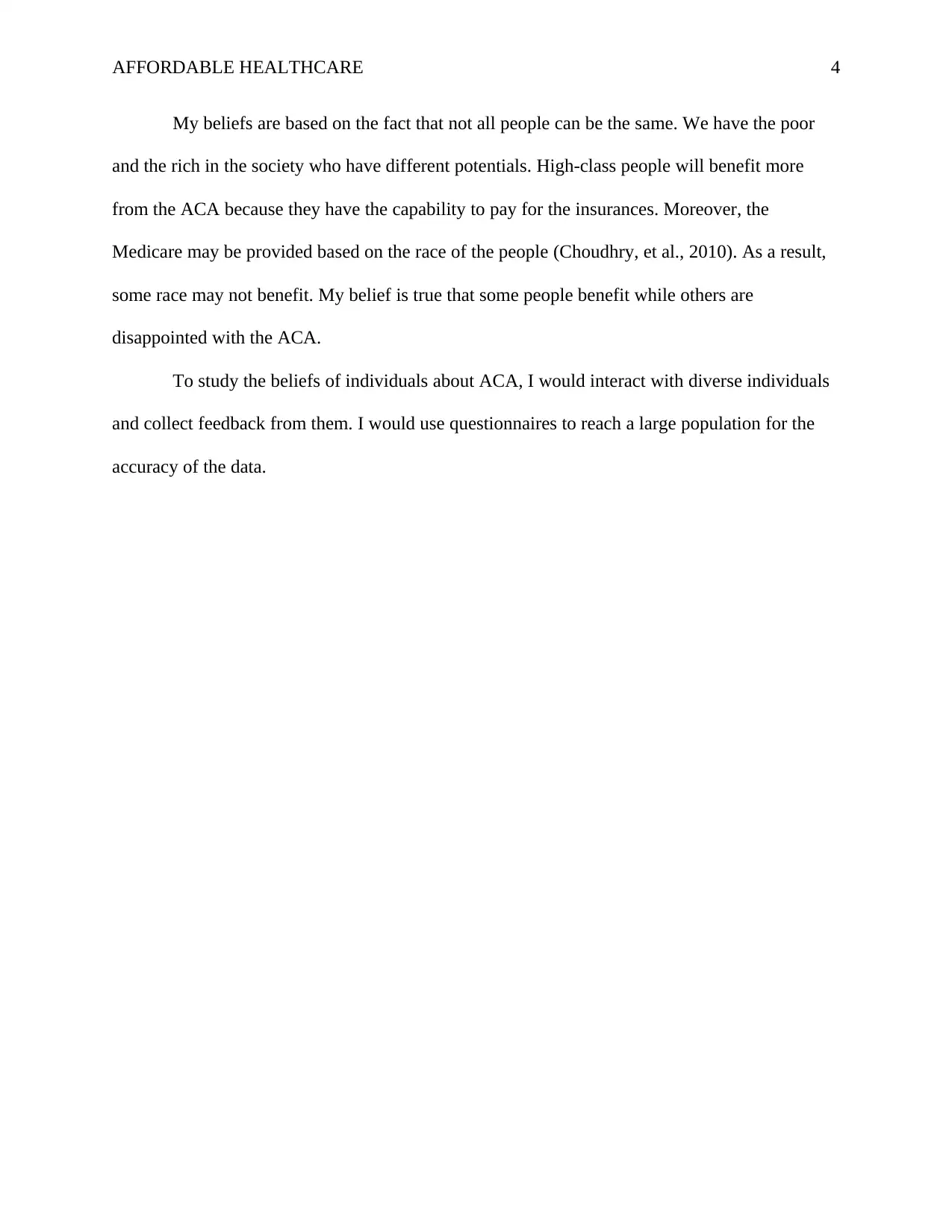
AFFORDABLE HEALTHCARE 4
My beliefs are based on the fact that not all people can be the same. We have the poor
and the rich in the society who have different potentials. High-class people will benefit more
from the ACA because they have the capability to pay for the insurances. Moreover, the
Medicare may be provided based on the race of the people (Choudhry, et al., 2010). As a result,
some race may not benefit. My belief is true that some people benefit while others are
disappointed with the ACA.
To study the beliefs of individuals about ACA, I would interact with diverse individuals
and collect feedback from them. I would use questionnaires to reach a large population for the
accuracy of the data.
My beliefs are based on the fact that not all people can be the same. We have the poor
and the rich in the society who have different potentials. High-class people will benefit more
from the ACA because they have the capability to pay for the insurances. Moreover, the
Medicare may be provided based on the race of the people (Choudhry, et al., 2010). As a result,
some race may not benefit. My belief is true that some people benefit while others are
disappointed with the ACA.
To study the beliefs of individuals about ACA, I would interact with diverse individuals
and collect feedback from them. I would use questionnaires to reach a large population for the
accuracy of the data.
Paraphrase This Document
Need a fresh take? Get an instant paraphrase of this document with our AI Paraphraser
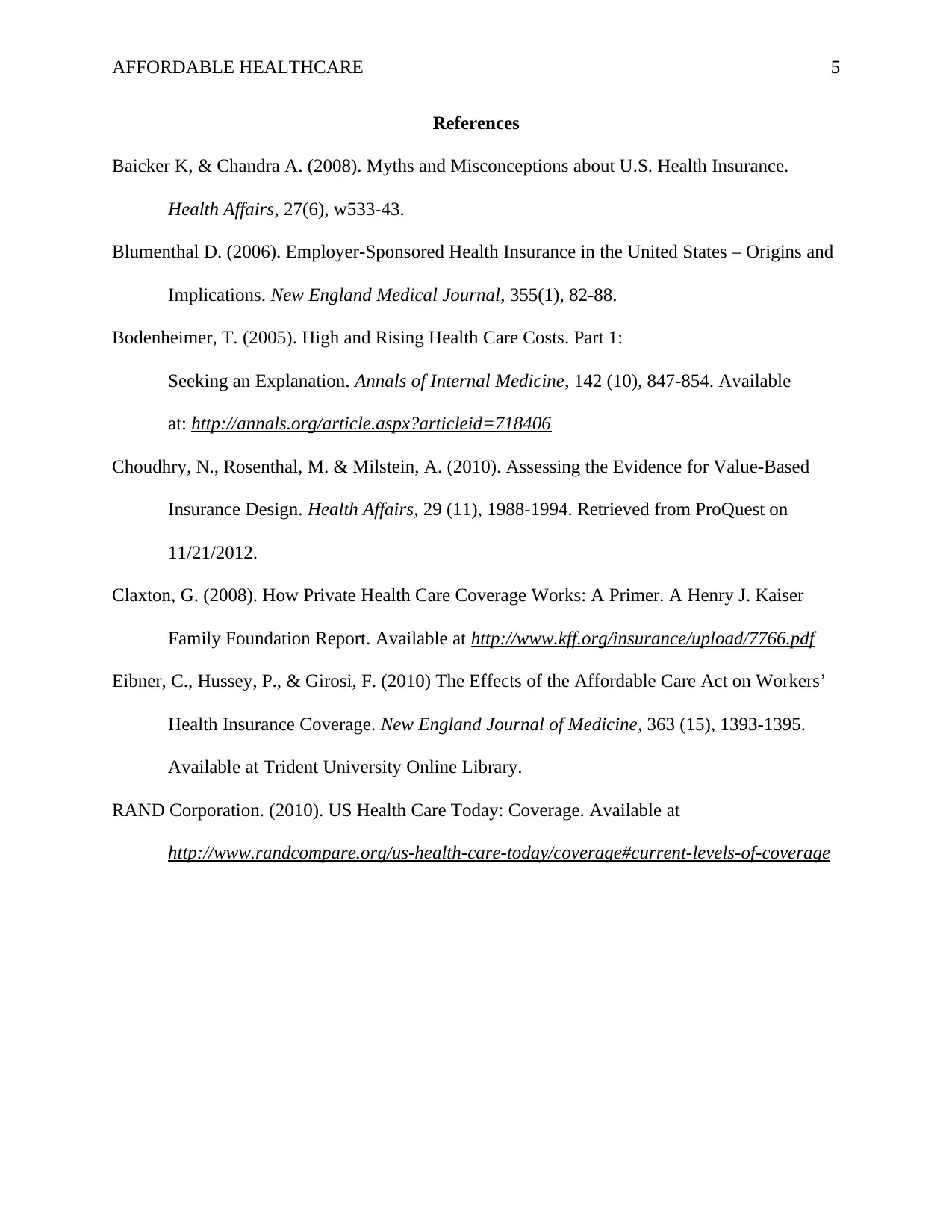
AFFORDABLE HEALTHCARE 5
References
Baicker K, & Chandra A. (2008). Myths and Misconceptions about U.S. Health Insurance.
Health Affairs, 27(6), w533-43.
Blumenthal D. (2006). Employer-Sponsored Health Insurance in the United States – Origins and
Implications. New England Medical Journal, 355(1), 82-88.
Bodenheimer, T. (2005). High and Rising Health Care Costs. Part 1:
Seeking an Explanation. Annals of Internal Medicine, 142 (10), 847-854. Available
at: http://annals.org/article.aspx?articleid=718406
Choudhry, N., Rosenthal, M. & Milstein, A. (2010). Assessing the Evidence for Value-Based
Insurance Design. Health Affairs, 29 (11), 1988-1994. Retrieved from ProQuest on
11/21/2012.
Claxton, G. (2008). How Private Health Care Coverage Works: A Primer. A Henry J. Kaiser
Family Foundation Report. Available at http://www.kff.org/insurance/upload/7766.pdf
Eibner, C., Hussey, P., & Girosi, F. (2010) The Effects of the Affordable Care Act on Workers’
Health Insurance Coverage. New England Journal of Medicine, 363 (15), 1393-1395.
Available at Trident University Online Library.
RAND Corporation. (2010). US Health Care Today: Coverage. Available at
http://www.randcompare.org/us-health-care-today/coverage#current-levels-of-coverage
References
Baicker K, & Chandra A. (2008). Myths and Misconceptions about U.S. Health Insurance.
Health Affairs, 27(6), w533-43.
Blumenthal D. (2006). Employer-Sponsored Health Insurance in the United States – Origins and
Implications. New England Medical Journal, 355(1), 82-88.
Bodenheimer, T. (2005). High and Rising Health Care Costs. Part 1:
Seeking an Explanation. Annals of Internal Medicine, 142 (10), 847-854. Available
at: http://annals.org/article.aspx?articleid=718406
Choudhry, N., Rosenthal, M. & Milstein, A. (2010). Assessing the Evidence for Value-Based
Insurance Design. Health Affairs, 29 (11), 1988-1994. Retrieved from ProQuest on
11/21/2012.
Claxton, G. (2008). How Private Health Care Coverage Works: A Primer. A Henry J. Kaiser
Family Foundation Report. Available at http://www.kff.org/insurance/upload/7766.pdf
Eibner, C., Hussey, P., & Girosi, F. (2010) The Effects of the Affordable Care Act on Workers’
Health Insurance Coverage. New England Journal of Medicine, 363 (15), 1393-1395.
Available at Trident University Online Library.
RAND Corporation. (2010). US Health Care Today: Coverage. Available at
http://www.randcompare.org/us-health-care-today/coverage#current-levels-of-coverage
1 out of 5
Related Documents
Your All-in-One AI-Powered Toolkit for Academic Success.
+13062052269
info@desklib.com
Available 24*7 on WhatsApp / Email
![[object Object]](/_next/static/media/star-bottom.7253800d.svg)
Unlock your academic potential
Copyright © 2020–2025 A2Z Services. All Rights Reserved. Developed and managed by ZUCOL.





